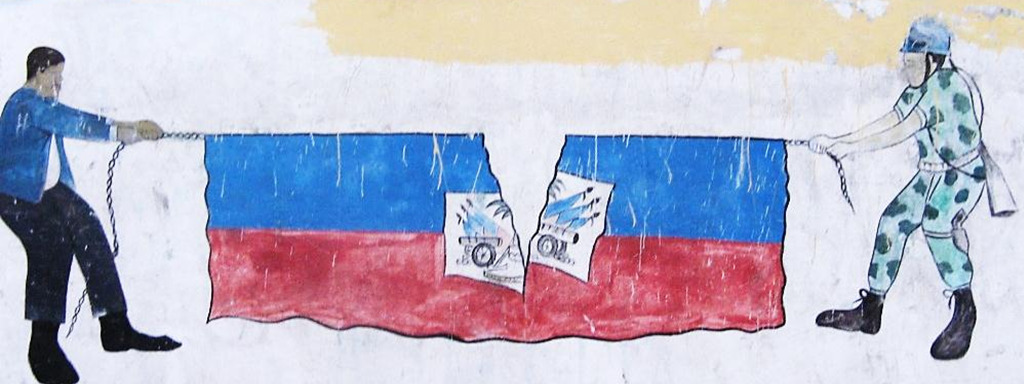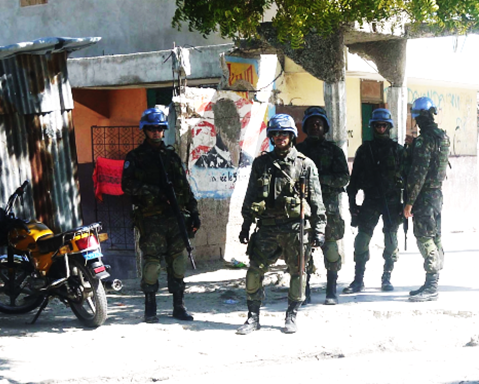"MINUSTAH" by Chelsey Kivland, Ph.D.
Kivland is Robert A. and Catherine L. McKennan Postdoctoral Teaching Fellow of Anthropology at Dartmouth College. Her forthcoming book will examine youth organizations, spiritual societies, street bands, and gangs in urban Haiti.
On June 1, 2004, the United Nations Stabilization Mission in Haiti (MINUSTAH) was implemented as Haiti’s fifth and current peacekeeping mission. Over eight years, MINUSTAH has assumed several roles, acting as a counter-insurgency effort, development corps, civilian police force, and humanitarian agency. It is credited with suppressing rioting and violence after the coup and facilitating the first democratic transfer of power between oppositional parties. However, the mission has faced widespread criticism for violating human rights, undermining the public sector, and triggering the Cholera epidemic.
UN Security Council Resolution 1542 (April 30, 2004) authorized the deployment of 6,700 military personnel and 1,622 police personnel from countries that have pledged service to UN peacekeeping. The corps is led by Brazilian and Chilean officials and has included enlisted soldiers from fifty different countries, with major constituencies from several Latin American countries as well as Jordan, Nepal, and Sri Lanka. The troops are paid by their respective governments with funds from United Nations member states.
MINUSTAH succeeded the US-led Multinational Interim Force, which was established after President Aristide departed Haiti for exile amid widespread political unrest. MINUSTAH’s original mandate was to support the transitional government in securing a stable and safe environment. This task centered on the disarmament and demobilization of armed actors who contested the coup against Aristide as well as criminal gangs that flourished in the political disorder. MINUSTAH was authorized to use force in several raids in the popular quarters, such as Bel Air and Cité Soleil, where Aristide had solidified a base of support. Independent studies of the mission documented excessive use of force and human rights abuses during these raids. From September to January 2004, an estimated 400 people were killed. Proponents of the mission, however, assert that these raids succeeded in suppressing the opposition and restoring order to the country.
Since 2004, MINUSTAH integrated security and development work under a mandate mandate to create a positive environment for democratic procedures and business investment. They partnered with national and executive police forces in enforcing the rule of law and elections and also with UN agencies, governmental aid agencies, and NGOs in the execution of development projects. These efforts were intended to reinforce the capacity of the state while securing the support of the population. However, several critics argued that the mission further weakened the government’s authority and control by assuming its role and claiming aid funds.
The 2010 earthquake marked a turning point in MINUSTAH. The administrative staff suffered severe losses when mission headquarters collapsed. Nevertheless, MINUSTAH quickly launched emergency relief operations alongside the United States and other governments. UN Resolution 1908 authorized an additional 3,500 troops to support immediate recovery and rebuilding.
The Cholera outbreak that swept through Haiti ten months after the earthquake, in mid-October, 2010, was linked to MINUSTAH troops stationed in Mirebalais near a tributary of the Artibonite River. To date, the disease has infected over 500,000 people and killed an estimated 8,000. The UN reported that sanitation conditions were not sufficient to prevent contamination of the river, but refused to acknowledge MINUSTAH troops as the source of the disease. The outbreak and the UN’s refusal to claim responsibility fomented anti-MINUSTAH protests throughout the country. On October 12, 2012, UN Resolution 2070 authorized the reduction of troops to the lowest point since its inception, leading many to anticipate a full withdrawal in the near future.


